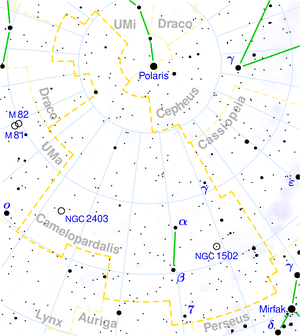
|
Camelopardalis ( from Ancient Greek καμηλοπάρδαλις - kamēlopardalis, Latin: giraffe), is the name of a large but faint northern constellation first recorded by Jakob Bartsch in 1624, but probably created earlier by Petrus Plancius. Notable features Although Camelopardalis is the 18th largest constellation, it is not a particularly bright constellation, as the brightest stars are only of fourth magnitude. β Camelopardalis is the brightest star, at apparent magnitude 4.03. This star is a double star, with components of magnitudes 4.0 and 7.4. The second brightest is CS Camelopardalis, which has neither a Bayer or Flamsteed designation. It is of magnitude 4.21 and is slightly variable. In some astronomical reference books, one will often see an alternate spelling of this constellation as Camelopardis. Notable deep sky objects NGC 2403 is a spiral galaxy approximately 11 million light years distant. It is of magnitude 8.4. NGC 1502 is a magnitude 6.0 open cluster about 6,800 light years distant. History Camelopardalis has no mythology associated with its stars, as it is a modern constellation. The faintness of the constellation, and that of the nearby constellation Lynx, lead to the early Greeks considering this area of the sky to be empty, and thus a desert. However, as a desert, together with other features in the Zodiac sign of Gemini (i.e. the Milky Way, and the constellations Gemini, Orion, Auriga, and Canis Major), this may be the origin of the myth of the cattle of Geryon, which forms one of The Twelve Labours of Herakles. Graphic visualization The stars of the constellation Camelopardalis can be connected in a fuller way, which graphically shows a giraffe. The giraffe's body consists of the quadrangle of stars α Cam, β Cam, BE Cam, and γ Cam: α Cam and β Cam being of the fourth magnitude.
Diagram of a fuller way to connect the stars of the constellation Camelopardalis, in order to show a giraffe.
The stars HD 42818 (HR 2209) and M Cam form the head of the giraffe, and the stars M Cam and α Cam form the giraffe's long neck. Stars β Cam and 7 Cam form the giraffe's front leg, and variable stars BE Cam and CS Cam form the giraffe's hind leg. References * H. A. Rey, The Stars — A New Way To See Them. Enlarged World-Wide Edition. Houghton Mifflin, Boston, 1997. ISBN 0-395-24830-2. * Ian Ridpath and Wil Tirion (2007). Stars and Planets Guide * NASA - Voyager Interstellar Mission Characteristics Links
Retrieved from "http://en.wikipedia.org/"
|
|


